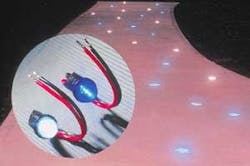LEDs create star-spangled driveway
Fluorescent and incandescent bulbs provide a few hundreds or thousands of hours of light before they flicker or flash to their demise. In contrast, light-emitting diodes (LEDs) intended for illumination are projected to last for decades. Such long life means that LEDs will come to be used less as light bulbs and more as architectural units to be integrated directly into structures. This shift in thinking is occurring already, and a driveway contractor from Flint, MI, is in its vanguard.
Bob Manning, who admits to being an astronomy buff, decided to adorn the new cement driveway he was installing at his own home with decorative lighting. While most people would line the driveway edges with lawn lights, he chose to embed fixtures into the driveway itself. Made to his specifications, the clear acrylic fixtures are shaped like moons and stars.
Manning's search for a light source that would match the 30-year longevity of the average concrete driveway brought him to the web site of LEDtronics (Torrance, CA), a company that buys raw LED chips, embeds them in plastic, then assembles the elements with electronic circuitry into items such as incandescent-bulb-replacement units, full-color display panels, and illuminated safety vests. He settled on gallium nitride-based white- and blue-emitting LEDs, which he mounted in his polymer shapes with silicone glue. "The end result produced the wow effect I was hoping for," says Manning. "You don't need total darkness; once the sun starts going down, the lights really come out."
The shock resistance and small size of LEDs are two other characteristics that will help spur the shift away from thinking of light sources as fragile, perishable objects. A company called The LED Light (Fallon, NV) has integrated white LEDs into handrails for boats, while LEDtronics itself makes visible LEDs down to 1.8 mm in size. However, cost—and, to a lesser extent, efficiency—still prevents white-emitting LEDs from putting old-style bulbs out of action.

